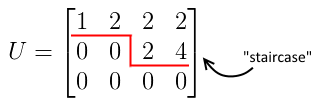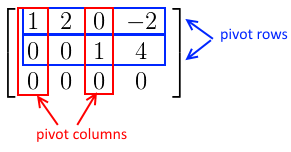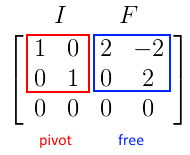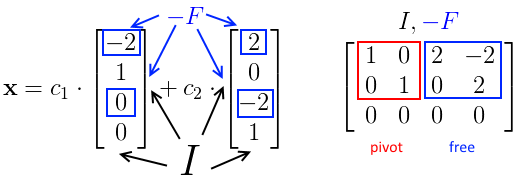Homogeneous Linear Systems $A\mathbf x = \mathbf 0$
Suppose we have a system $A\mathbf x = \mathbf 0$. Such a system is called ‘‘homogeneous’’ - because we have $\mathbf 0$ on the right side of the system.
Solving $A\mathbf x = \mathbf 0$
How to solve such a system?
- The solutions to this system form Nullspace $N(A)$
- we can solve it with Gaussian Elimination. The elimination doesn’t change $N(A)$ - the solutions remain the same if we linearly combine the rows
- but note that the elimination changes the Column Space $C(A)$ of $A$
Elimination and Echelon Form
Suppose we have a matrix $A =
\begin{bmatrix}
1 & 2 & 2 & 2 \
2 & 4 & 6 & 8
3 & 6 & 8 & 10
\end{bmatrix}$
- note that row 3 is a linear combination of row 1 and row 2 (the system is not linearly independent)
- while doing the elimination we’ll notice it
Let’s do it:
- $\begin{bmatrix}
\boxed 1 & 2 & 2 & 2 \
2 & 4 & 6 & 8
3 & 6 & 8 & 10
\end{bmatrix} \to \begin{bmatrix} \boxed 1 & 2 & 2 & 2 \ 0 & 0 & 2 & 4
0 & 0 & 2 & 4
\end{bmatrix}$ - we have 0’s in the second column, but in the next column there’s a non-zero value - can take it as a pivot| |- $\begin{bmatrix} |\boxed 1 & 2 & 2 & 2 \
0 & 0 & \boxed 2 & 4
0 & 0 & 2 & 4
\end{bmatrix} \to \begin{bmatrix} \boxed 1 & 2 & 2 & 2 \ 0 & 0 & \boxed 2 & 4
0 & 0 & 0 & 0
\end{bmatrix} = U$ - it’s not really an upper-triangular matrix, but we still can call it $U$
- this $U$ is in the ‘‘echelon form’’ (or “staircase” form)

'’rank’’ $r$ of a matrix is the number of Pivot variables in the echelon form
During the elimination the nullspace $N(A)$ of $A$ doesn’t change
- so systems $A\mathbf x = \mathbf 0$ and $U \mathbf x = \mathbf 0$ have the same solutions $\mathbf x$
- the column with pivot variables are called ‘‘pivot columns’’, there are $r$ of them
- the rest of the columns are called ‘‘free columns’’, there are $n - r$ of them

Now let’s try to solve this system
$\left{\begin{array}{rl}
x_1 + 2 x_2 + 2 x_3 + 2 x_4 & = 0
2 x_3 + 4 x_4 & = 0
\end{array}\right.$
We can find some solutions for pivot variables, but what to do with the free ones?
- They can have any value
-
So we may assign something to them and then solve the system with backsubstitution for the pivot variables
- E.g. let’s assign 1 and 0 to $x_2$ and $x_4$
- we have $\mathbb x = \begin{bmatrix} x_1 \ 1 \ x_3 \ 0 \end{bmatrix}$, then we solve the system and get $\mathbb x = \begin{bmatrix} -2 \ 1 \ 0 \ 0 \end{bmatrix}$
- we can also take any linear combination of this solution, so we should write $\mathbb x = c_1 \cdot \begin{bmatrix} -2 \ 1 \ 0 \ 0 \end{bmatrix}$
- what if we assign different values to $x_2$ and $x_4$?
- Can assign this way: $\mathbb x = \begin{bmatrix} x_1 \ 0 \ x_3 \ 1 \end{bmatrix}$, then we solve and get $\mathbb x = \begin{bmatrix} 2 \ 0 \ -2 \ 1 \end{bmatrix}$
- so we have another “special” solution $\mathbb x = c_2 \cdot \begin{bmatrix} 2 \ 0 \ -2 \ 1 \end{bmatrix}$
- so the final solution to this system will be
- $\mathbf x = c_1 \cdot \begin{bmatrix} -2 \ 1 \ 0 \ 0 \end{bmatrix} + c_2 \cdot \begin{bmatrix} 2 \ 0 \ -2 \ 1 \end{bmatrix}$
- this is the Nullspace $N(A)$ of the matrix $A$
Row Reduced Echelon Form
Can we do simpler?
Suppose we have matrix $A$ that we reduced to $U = \begin{bmatrix}
\boxed 1 & 2 & 2 & 2 \
0 & 0 & \boxed 2 & 4
0 & 0 & 0 & 0
\end{bmatrix}$
- can we clean it further? Can try to clean the pivot columns upwards - so there’s only one 1 and the rest are 0’s
- $U = \begin{bmatrix}
\boxed 1 & 2 & 2 & 2 \
0 & 0 & \boxed 2 & 4
0 & 0 & 0 & 0
\end{bmatrix} \to \begin{bmatrix} \boxed 1 & 2 & 0 & -2 \ 0 & 0 & \boxed 1 & 4
0 & 0 & 0 & 0
\end{bmatrix} = R$ - $R$ is a ‘‘Row Reduced Echelon Form’’ (RRFR) of $A$

- note that if we consider only the pivot rows and columns, we see that we have the identity matrix $\begin{bmatrix}
1 & 0
0 & 1
\end{bmatrix}$
So now if we take a look at our new system, we have
- $\left{\begin{array}{rl}
x_1 + 2 x_2 - 2 x_4 & = 0
x_3 + 2 x_4 & = 0
\end{array}\right.$ - $A \mathbf x = \mathbf 0$, $U \mathbf x = \mathbf 0$ and $R \mathbf x = \mathbf 0$ - all have the same solutions $\mathbf x$| | | Let’s rearrange columns in $R$ so first we have the pivot columns, and then the free columns
- $\begin{bmatrix}
1 & 0 & 2 & -2 \
0 & 1 & 0 & 2
0 & 0 & 0 & 0
\end{bmatrix}$ - now can distinguish the $I$ part (identity) and the $F$ part (free)

-
these $I$ and $F$ appear in the “special” solutions of the $U \mathbf x = \mathbf 0$ - only $F$ comes with the minus sign: - 
Why does it happen?
- assume we have a RREF $R = \begin{bmatrix}
I & F
0 & 0
\end{bmatrix}$ - we have $r$ pivot columns, $n-r$ free columns and $r$ pivot rows
- we want to solve $R\mathbf x = \mathbf 0$. What are the “special” solutions?
- let’s create a ‘‘Nullspace matrix’’ $N$, $N = \begin{bmatrix} -F \ I \end{bmatrix}$
- Columns of $N$ are our special solutions
- let’s take a closer look at one of these columns $\begin{bmatrix}
\mathop{\mathbf x_\text{pivot}}\limits_\mathop{\mathbf x_\text{free}}\limits_\end{bmatrix}$. The system is $\begin{bmatrix}
I & F
0 & 0
\end{bmatrix} \cdot \begin{bmatrix} \mathop{\mathbf x_\text{pivot}}\limits_\mathop{\mathbf x_\text{free}}\limits_\end{bmatrix} = \mathbf 0$ - $\Rightarrow$ $I x_\text{pivot} + F x_\text{free} = \mathbf 0$ or $x_\text{pivot} = - F x_\text{free}$
- where for $x_\text{free}$ we use “special” choices $\mathbf e_1, \mathbf e_2, …$ (columns of $I$)